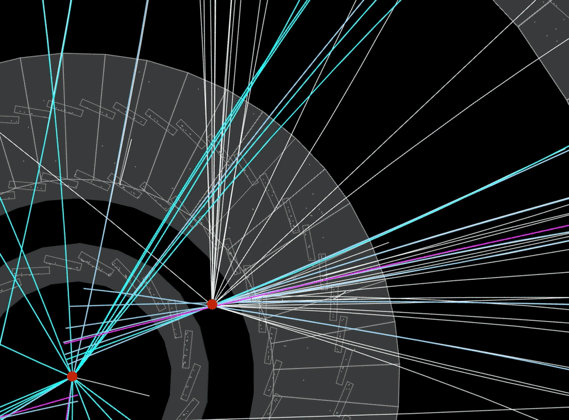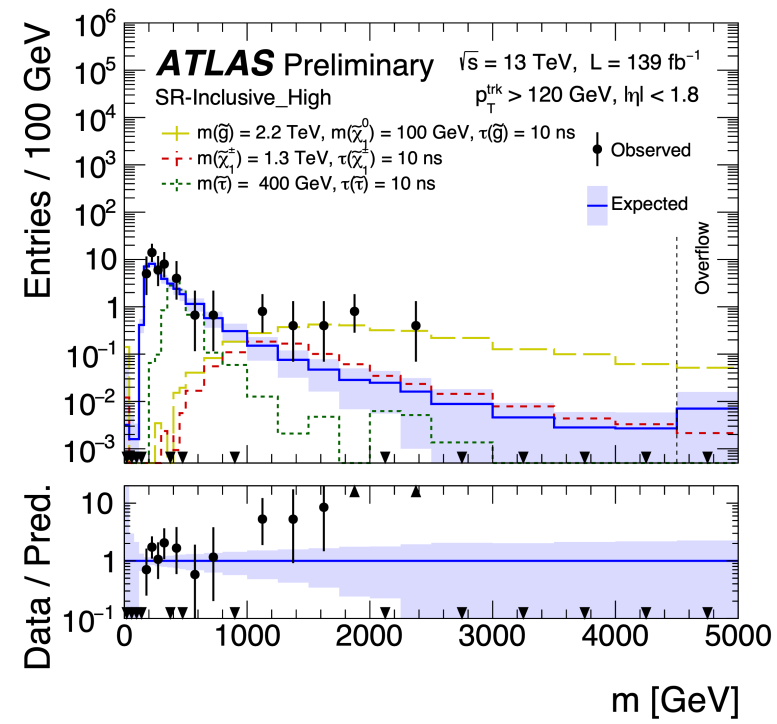ATLAS event display for a data event with a pair of “displaced jets”, which are narrow, largely trackless and have most of their energy in the hadronic part of the calorimeter. Credit: CERN
Physicists at the ATLAS experiment are on the hunt for new, long-lived particles to help explain several outstanding mysteries of our Universe.
Physicists at the ATLAS experiment are on the hunt for new, long-lived particles to help explain several outstanding mysteries of our Universe. High-energy collisions allow researchers to study heavy particles that decay very quickly, like the Higgs boson. But unlike heavy Standard Model particles – which decay within a few millimeters of the Large Hadron Collider (LHC) collision point – new, long-lived particles (LLPs) could travel sizeable distances through the ATLAS detector before decaying.
Studying the decay of any particle is a complex task, but it is usually made much easier by assuming that it decayed near the LHC collision point. This leaves LLPs in a blind spot, as they could decay anywhere in the detector. Further, as the layers of the ATLAS experiment are instrumented differently, evidence of LLPs would look different depending on which layer the particle decays in.
To ensure no stone is left unturned, ATLAS physicists have devised a range of new strategies to look for LLPs with various possible characteristics. Four new results from this effort have been presented at the recent Lepton-Photon and La Thuile conferences.
The hunt for right-handed neutrinos
Neutrinos are some of the most mysterious particles in the Standard Model. Physicists have long puzzled over why neutrinos are only ever observed to be “left-handed” (i.e. their spin and momentum are opposed), while all other known particles can also be observed in “right-handed” states.

Figure 1: Display of a simulated event where a neutral long-lived particle is produced at the centre of the detector (left red dot) and decays after traversing some distance (right red dot). This signature is known as a “displaced vertex.” Credit: ATLAS Collaboration/CERN
One possibility is that right-handed neutrinos exist but are very heavy, and therefore harder to produce in nature. These new particles – called “heavy neutral leptons” (HNLs) – would simultaneously provide right-handed partners to Standard Model neutrinos and explain why neutrinos are so light. If the interaction strength between HNLs and Standard Model neutrinos is small, HNLs would display long-lived experimental signatures.
In a new search for these heavy neutrinos, ATLAS physicists looked for leptons originating from a common displaced vertex (see Figure 1) in the ATLAS charged-particle tracking detector, where a HNL could have decayed to a mixture of electrons, muons and missing energy. Using the decay products, they reconstructed the possible HNL mass which would be different for signal events than for background events, as shown in Figure 2. As a result, physicists were able to set limits on HNL masses between 3 and ~15 GeV, and were able to report on HNL decays to electron-muon pairs for the very first time!

Figure 2: The reconstructed HNL mass distribution for the observed data (black dots), the predicted background with its uncertainty (lilac/blue), and simulated signal for three different mass hypotheses (colored lines). Credit: ATLAS Collaboration/CERN
The ATLAS Collaboration has devised a range of new strategies to look for long-lived particles that decay away from the central LHC collision point.
Following the steps of charged LLPs
When searching for new particles, physicists have to look for their decay products – or do they? A recent ATLAS analysis takes a different approach. If a new, heavy charged LLP exists, it would leave energy deposits in the ATLAS tracking detector. If the particle is heavy, these energy deposits would be abnormally large and could be used to infer the mass of the particle that produced them. This is an exceptional case where physicists could actually detect a new particle directly, and not just via its decay.

Figure 3: The reconstructed mass spectrum for the Standard Model expectation (blue line) and observed data (black dots). Different possible signals that are tested by the search are shown in dashed colours. A small excess of events is observed above 1000 GeV in mass, which is however not compatible with a slow charged particle hypothesis when looking into time measurements. Credit: ATLAS Collaboration/CERN
However, predicting the Standard Model background processes in this search is very challenging. ATLAS physicists employed a sophisticated “data-driven” method to tackle the problem, using tracks with regular energy deposits to predict the background processes that could mimic a signal.
The observed data agree with the expected Standard Model background, except for the presence of several events forming an excess in a high-energy and high-mass region, as shown in Figure 3. Although intriguing, the time-of-flight measurements in outer detector subsystems indicate that none of the candidate tracks match the heavy and slow-moving charged particle hypothesis.
Harnessing the power of machine learning
When particles decay to quarks, they undergo a process called hadronization, which leads to sprays of collimated particles in the ATLAS detector called jets. If a new, neutral LLP were to decay to quarks in the outer layer of the calorimeter, it would leave behind “displaced” jets. These would leave to a very unusual signature in the experiment: the jets would have no associated particle trajectories in the tracking detector; would be very narrow compared to their Standard Model counterparts, since the spray of particles wouldn’t have time to become spatially separated; and would leave a high fraction of their total energy in the hadronic part of the calorimeter. An example of one of these unusual jets can be seen in the event display above.
In a new analysis, ATLAS researchers exploited the uncommon characteristics of displaced jets to search for pairs of neutral LLPs decaying in the calorimeter. The Deep Neural Network they developed for the analysis is particularly novel: it is able to distinguish displaced jets from background interactions of the LHC beam with material from the accelerator itself, as well as from jets from Standard Model quark decays. Further, researchers used an adversarial training scheme to ensure the algorithm did not exploit known differences between data and simulation. The result was used to estimate the background for the search, and no significant excess of events has been spotted so far.
But what if the neutral LLP decays to leptons instead of quarks? Dark photons are a class of LLPs speculated to behave in this way. If such decays were to occur in the ATLAS calorimeter or muon system, they would result in collimated groups of leptons called lepton-jets.
Researchers also searched for lepton-jets in another new analysis, using state-of-the-art machine-learning techniques to distinguish LLP-candidate lepton-jets from background processes, such as cosmic rays and LHC beam-gas interactions. For the first time, ATLAS physicists searched for new particles using machine learning techniques exploiting patterns of raw energy deposits in each layer of the detector. Although no excess of events was seen, they set stringent new limits on the existence of dark photons and were able to probe dark-photon decays to electrons for the very first time!
Into Run 3
At the core of these new analyses is one key question: what if new particles are hiding from standard searches? ATLAS researchers have developed novel, creative ways to explore the rich diversity of possible LLP decays. Their wide array of dedicated searches uses new techniques to tackle unusual backgrounds. The search continues, with Run 3 of the LHC promising new data and new innovations to further this exciting program of research.





